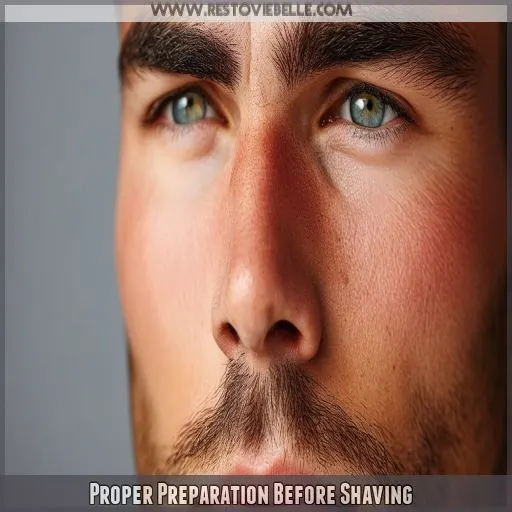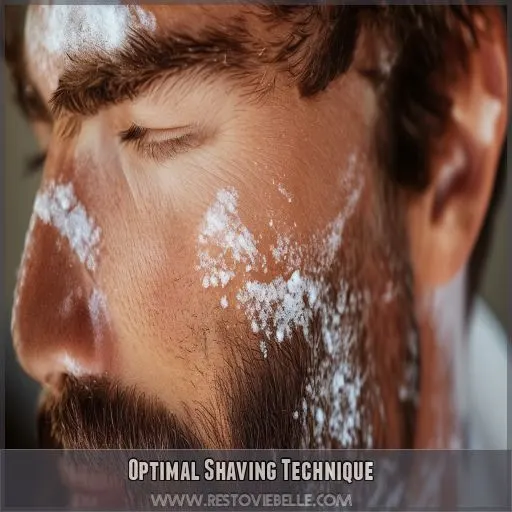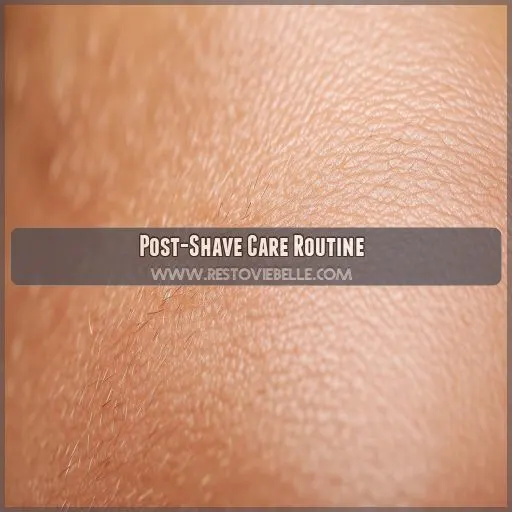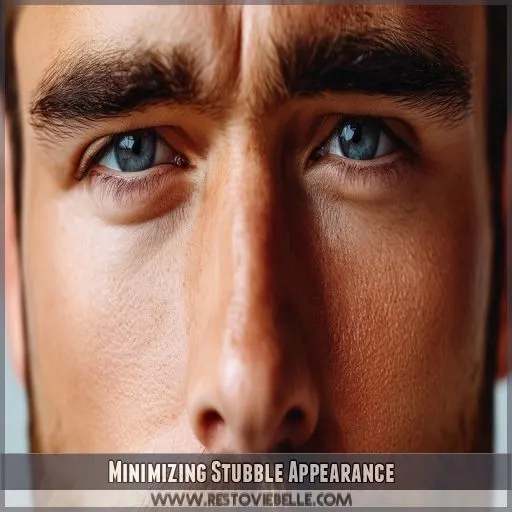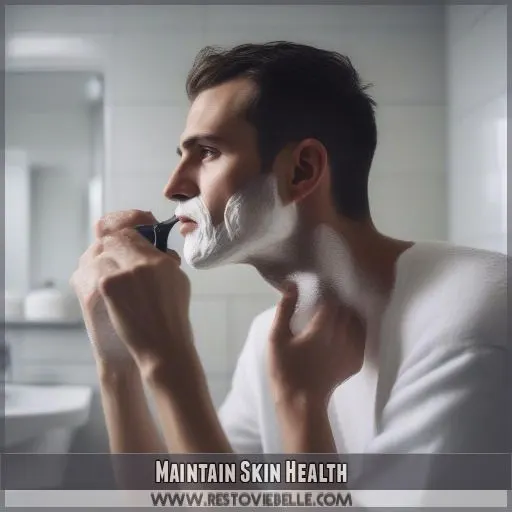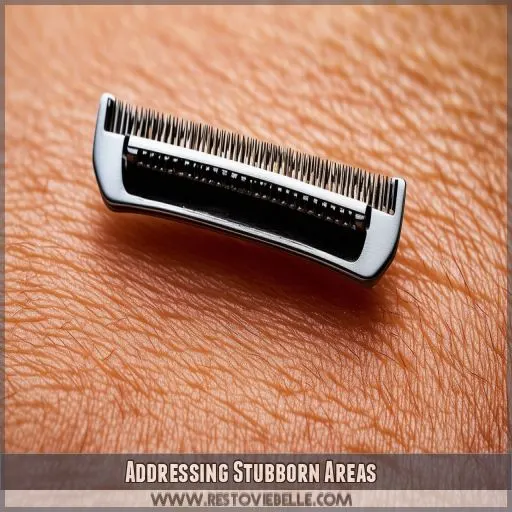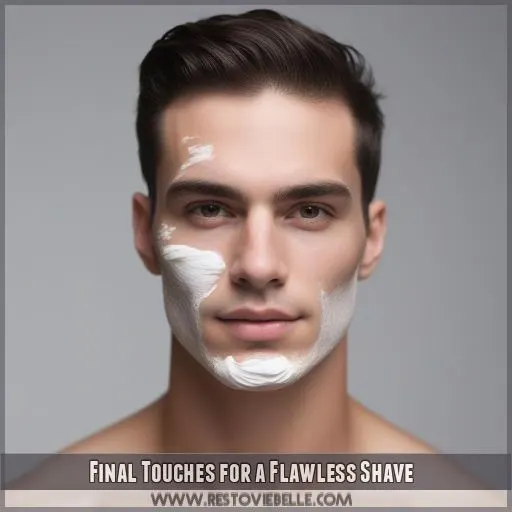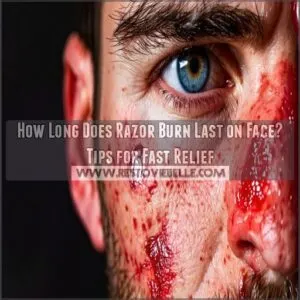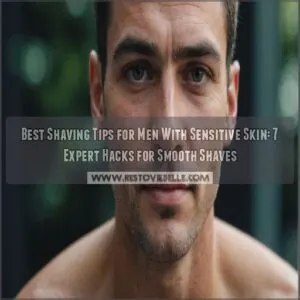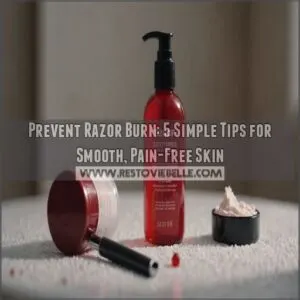This site is supported by our readers. We may earn a commission, at no cost to you, if you purchase through links.
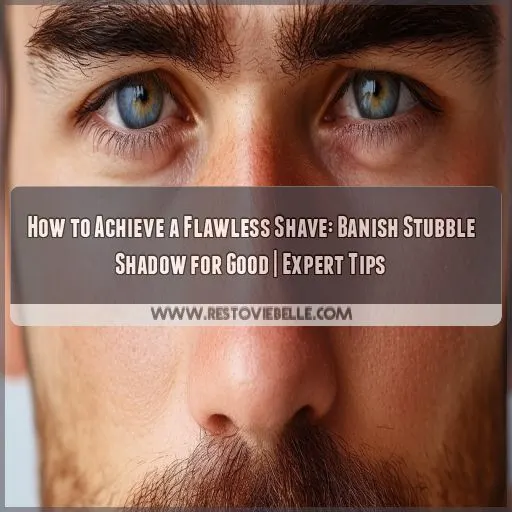
This guide has expert tips to help you finally get rid of that annoying stubble. Inside, you will find how to properly prepare, the best ways to shave, and after-shave care routines.
We will also cover ways to minimize the appearance of unwanted stubble, maintain healthy skin, and deal with those really hard areas or spots.
Master these steps and you’ll be well on your way to a clean, shadow-free shave every time.
Table Of Contents
- Key Takeaways
- How to Achieve a Flawless Shave Without the Pesky “shadow”?
- Proper Preparation Before Shaving
- Optimal Shaving Technique
- Post-Shave Care Routine
- Minimizing Stubble Appearance
- Maintain Skin Health
- Addressing Stubborn Areas
- Final Touches for a Flawless Shave
- Frequently Asked Questions (FAQs)
- How do you shave so there is no shadow?
- How to get rid of shadow after shaving head?
- How do you get the smoothest shave ever?
- How do you shave but keep 5 o’clock shadow?
- How often should I replace my razor blade?
- Can certain foods affect facial hair growth?
- Are there any natural remedies for ingrown hairs?
- Does shaving cream expire? How long does it last?
- Can hormonal changes impact the effectiveness of shaving?
- Conclusion
Key Takeaways
- Prep like a pro: Open those pores with warm water and slick up your face with pre-shave oil. It’s like giving your razor a red carpet to glide on!
- Master the grain game: Start with the grain, then go against it if you dare. But watch out – shaving against the grain is like poking a bear; it might bite back with razor burn!
- Cool it down and moisturize: Splash some cold water on your face to close those pores, then slap on some moisturizer. Your skin will thank you, and you’ll look as smooth as a freshly waxed sports car.
- Tackle those trouble spots: Don’t let stubborn shadows rain on your parade. Adjust your technique for tricky areas and keep your hair length consistent. Remember, Rome wasn’t built in a day, and neither is the perfect shave!
How to Achieve a Flawless Shave Without the Pesky “shadow”?
To achieve a flawless shave without the pesky "shadow," start by prepping your face with warm water and pre-shave oil. Shave with the grain using light pressure, then carefully go against it for a closer cut. Rinse with cold water and apply a suitable moisturizer.
Keep stubble neat by trimming regularly and exfoliating to prevent ingrown hairs. Focus on darker areas, adjusting your technique as needed.
Evaluate your routine and check for missed spots before finishing.
Proper Preparation Before Shaving
Start your shaving routine by washing your face with warm water to open up your pores and soften the hair. Next, apply a pre-shave oil to lubricate your skin, which will help the razor glide smoothly and reduce irritation during shaving.
Wash Face With Warm Water
Start shaving by washing your face in some warm water first. This very important action:
- Opens up your pores, softening prickly hair
- Removes dirt and oil, preparing your skin
- It improves razor glide, thereby reducing irritation.
The heat relaxes your skin, and this in turn makes it easier to lather. Be sure to choose a mild cleanser that will suit your skin type and how often you shave. This can set up for the easier shave with shaving soap or cream.
Apply Pre-Shave Oil
Before you grab that razor, give your skin a fighting chance. Apply pre-shave oil to create a slick barrier, reducing friction and irritation.
It’s a game-changer for all skin types, especially if you’re prone to razor burn. Massage a few drops into damp skin, focusing on trouble spots.
Can’t find shaving oil? Try a light facial oil instead.
Your face will thank you for this extra step in your shaving routine.
Optimal Shaving Technique
To achieve a flawless shave, start by shaving with the grain of your hair growth, using gentle strokes to minimize irritation. If necessary for a closer shave, carefully shave against the grain in a second pass, but be cautious as this can increase the risk of razor burn and ingrown hairs.
Shave With the Grain First
To banish that pesky 5 o’clock shadow, start by shaving with the grain. This technique reduces irritation and prevents ingrown hairs. Here’s your game plan:
- Map your grain direction
- Hold your razor at a 30-degree angle
- Apply gentle pressure and use slow, steady strokes
Shave Against the Grain Carefully
After shaving with the grain, you can carefully go against it for an even closer shave.
But beware: this increases your risk of razor burn, ingrown hairs, and skin irritation.
Use light pressure and short strokes, letting your razor choice do the work. If you’re prone to razor bumps, consider skipping this step.
Always shave carefully to avoid a painful shaving rash.
Post-Shave Care Routine
After shaving, rinse your face thoroughly with cold water to close pores and soothe the skin. Follow up by applying a suitable moisturizer to hydrate and protect your freshly shaved skin, which will help prevent irritation and maintain a smooth appearance.
Rinse Face With Cold Water
After the close shave, it’s time to cool things down. Rinse your face with cold water as part of your post-shave care routine. This essential step offers various benefits:
- Closes pores, reducing the risk of ingrown hairs
- Reduces skin temperature, lowering redness and inflammation
- Tightens skin, giving you a more refreshed appearance
- Prevents the dreaded 5 o’clock shadow by slowing hair growth.
Cold water is your weapon for achieving perfection in the irritation-free, wet shave you seek.
Apply Moisturizer After Shaving
After shaving, one of the most important steps is to moisturize and repair your skin’s moisture barrier. Use an aftershave balm or facial lotions, depending on the one that best suits your skin type. Here is a quick guide:
| Type | Benefits | Best For |
|---|---|---|
| Aftershave Balm | Soothes, moisturizes | for sensitive skin |
| Alum Block | Antiseptic, astringent | Oily skin |
| Facial Moisturizer | Light Moisturizing | Normal Skin |
| Deep moisturising | Deep nourishment | Dry skin |
| Shaving Cream | Protection All Day | For Every Skin Type |
Apply your chosen product gently, focusing on areas prone to irritation.
Minimizing Stubble Appearance
To minimize stubble appearance, maintain a consistent hair length by trimming regularly with a quality electric trimmer or razor. Keep your stubble neat by combing it to distribute hair evenly and trimming any stray or longer hairs that may stand out.
Keep Hair Length Consistent
Keeping your facial hair at a consistent length after your post-shave routine gives you this polished look. Knowing the growth pattern and thickness will help you distribute it evenly. These are factors to consider:
- Your individual facial form
• Hair direction across different areas
- Varying hair thickness from cheeks to neck
- Growth rate differences throughout your face
Shave less aggressively where necessary to adjust the technique. This will leave you looking sharp all day, with a more uniform appearance that minimizes that dreaded stubble shadow.
Trim Stubble Neatly
To actually hit that length of stubble, you’ll want neat trimming. Invest in good hair clippers and adjustable guards for variable length control over your 5 o’clock shadow.
Exfoliate your skin to avoid ingrown hairs and ensure an even trim. Take note of shapes, thickness, and color of the stubble.
Keeping your stubble regularly maintained will keep you looking sharp and reduce the appearance of patchiness.
Don’t forget to clean your trimming equipment after every use to keep it working at its best.
Maintain Skin Health
To maintain healthy skin and achieve a flawless shave, you’ll need to exfoliate regularly. This process removes dead skin cells, unclogs pores, and allows for a closer shave, helping to minimize the appearance of stubble shadow and reduce irritation.
Exfoliate Skin Regularly
Exfoliate regularly for the health of your skin and better shaves. This very important step will remove dead skin cells, clear your pores, and lead to a closer shave.
You want to exfoliate 2 or 3 times a week with a gentle, round motion. Use a product that will suit your skin type, or you can try this simple homemade scrub: sugar mixed with olive oil.
Do this before applying pre-shave oil or lathering with shaving soap for the best results.
Addressing Stubborn Areas
To tackle stubborn areas of beard shadow, focus on the darker patches where hair growth is more pronounced. Adjust your shaving technique for these spots by using shorter strokes and applying slightly more pressure, ensuring you’re thorough without causing irritation.
Focus on Darker Shadow Patches
After maintaining your skin’s health, it’s time to tackle those pesky darker shadow patches. These stubborn areas often crop up along the jawline or neck, creating that dreaded 5 o’clock shadow.
To combat this, pay extra attention to grain direction when shaving these spots. Apply pre-shave oil liberally and consider using a straight razor for a closer shave.
Don’t forget to exfoliate regularly to prevent ingrown hairs in these trouble zones.
Adjust Shaving Technique Accordingly
Once you’ve identified those stubborn shadow patches, it’s time to adjust your technique.
For areas with dense stubble growth, consider using shaving oil or balm for extra lubrication. Switch between a safety razor for precision and electric shavers for speed.
In really tough spots, try a more aggressive shave against the grain, but be cautious.
Follow up with cool water to close pores and minimize that pesky 5 o’clock shadow.
Final Touches for a Flawless Shave
To achieve a flawless shave, regularly evaluate and refine your shaving routine, adapting techniques as needed for your skin and hair type. Before finishing, carefully inspect your face for any missed spots or areas that need extra attention, ensuring a smooth and even result.
Evaluate and Refine Your Routine
Now, after working on those rough spots, it’s time to get down to detail. Play around with products that hydrate the skin or make a five o’clock shadow less apparent. Keep your razor really sharp for a close shave.
See how your skin responds, and trim as needed. Be sure not to forget filling your dopp kit or shaving bag with supplies when traveling.
After all, it may take some trial and error to perfect it just right.
Check for Missed Spots Before Finishing
After refining your routine, don’t rush to finish. Carefully inspect your face for any missed spots. Run your fingers over your skin to feel for stubble, paying extra attention to tricky areas like the neck and jawline. Adjust your shaving angle and reapply lather if needed. Consider these final checks:
- Tilt your head back to catch light on remaining stubble
- Use a magnifying mirror for precision touch-ups
- Gently stretch skin to reveal hidden patches
- Double-check problem areas prone to 5 o’clock shadow
Frequently Asked Questions (FAQs)
How do you shave so there is no shadow?
You’ll need a sharp razor, quality shaving cream, and proper technique. Shave with the grain, then across, and finally against. Exfoliate beforehand, use warm water, and moisturize after. Consistency is key for a shadow-free result.
How to get rid of shadow after shaving head?
Like smoothing a marble surface, achieving a shadowless shaved head requires precision. Exfoliate first, use a sharp razor with shaving cream, shave with the grain, rinse frequently, and apply moisturizer. For stubborn shadows, consider depilatory creams or professional treatments.
How do you get the smoothest shave ever?
You’ll get the smoothest shave by exfoliating first, using a sharp razor with quality shaving cream, shaving with the grain, then against it. Rinse with cold water and apply moisturizer. Don’t forget to replace your razor regularly.
How do you shave but keep 5 o’clock shadow?
Time to walk the razor’s edge! To maintain a 5 o’clock shadow, trim your facial hair to about 3-5mm using an electric trimmer. Adjust the guard setting for desired length. Shave the neck area for a cleaner look.
How often should I replace my razor blade?
You should replace your razor blade every 5-7 shaves, or when you notice tugging, irritation, or decreased performance. Dull blades increase the risk of nicks, cuts, and that pesky shadow. Don’t skimp on blade quality or frequency.
Can certain foods affect facial hair growth?
Ever wondered if your diet affects your beard? Yes, it can. Certain nutrients like vitamins A, C, and E, biotin, and protein can influence facial hair growth. A balanced diet rich in these elements may promote healthier, fuller facial hair.
Are there any natural remedies for ingrown hairs?
You can combat ingrown hairs naturally with exfoliation, tea tree oil, and warm compresses. Try sugar scrubs to remove dead skin, apply diluted tea tree oil for its antibacterial properties, and use warm compresses to soothe irritation and encourage hair growth.
Does shaving cream expire? How long does it last?
Imagine this. Your shaving cream, which once glided, servicably smooth, has turned into some crusty relic. Yes, it does expire! Typically lasting 2-3 years unopened, 12-18 months after opening. Check for changes in color, texture, or smell to determine if it’s past its prime.
Can hormonal changes impact the effectiveness of shaving?
Yes, hormonal changes can be presupposed to affect your shaving effectiveness since they may alter the patterns of hair growth, thickness, and skin sensitivity. You feel the differences at puberty, pregnancy, or at menopause. Adjust accordingly in order to get the best results in shaving.
Conclusion
Think of the perfect shave like Sisyphus and his boulder: it becomes a never-ending struggle.
But now, after reading through expert tips, you’re better prepared to say adios once and for all to that pesky shadow of your stubble.
And remember, proper preparation, optimal technique, and diligent post-shave care are the allies you have to make it happen.
With this guide on how to get a flawless shave sans shadow, you’ll be able to master the art of smooth skin.
Be persistent, adjust your technique slightly, and pretty soon you’ll be getting that clean, shadow-free shave each and every time.

